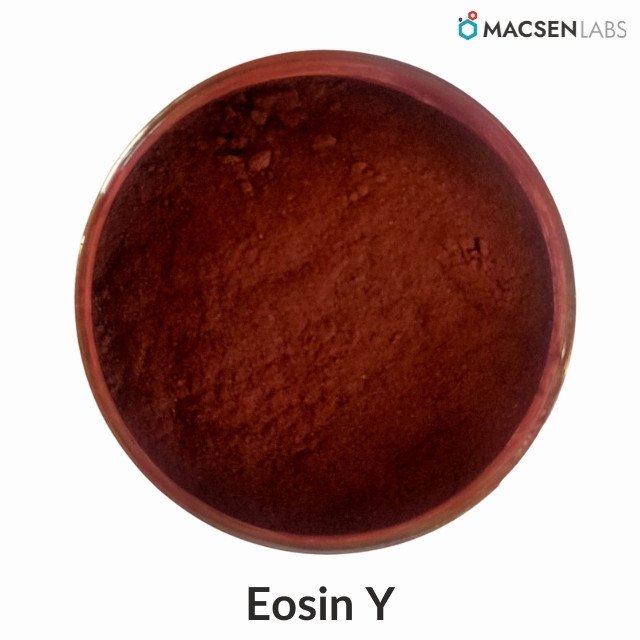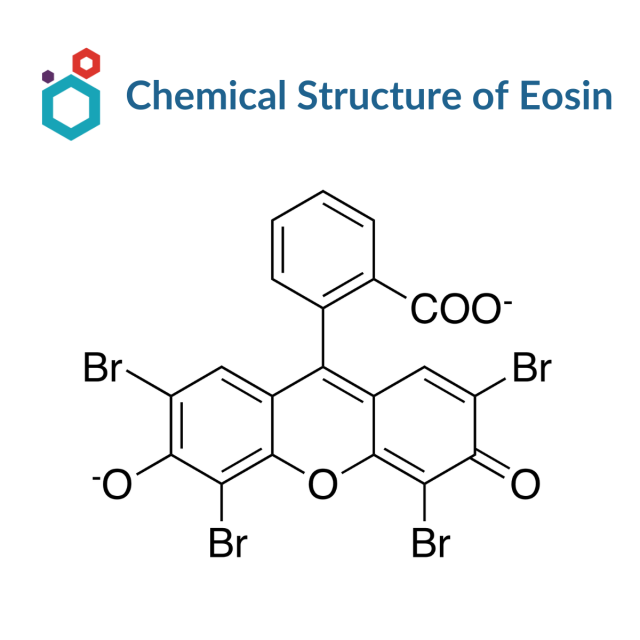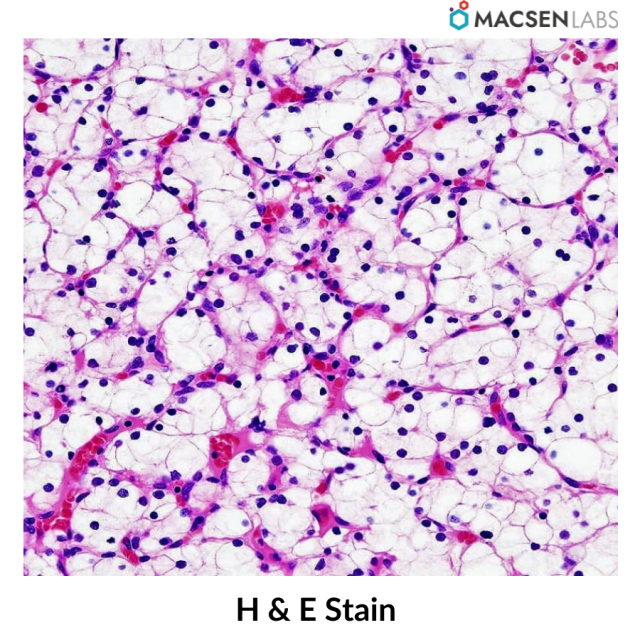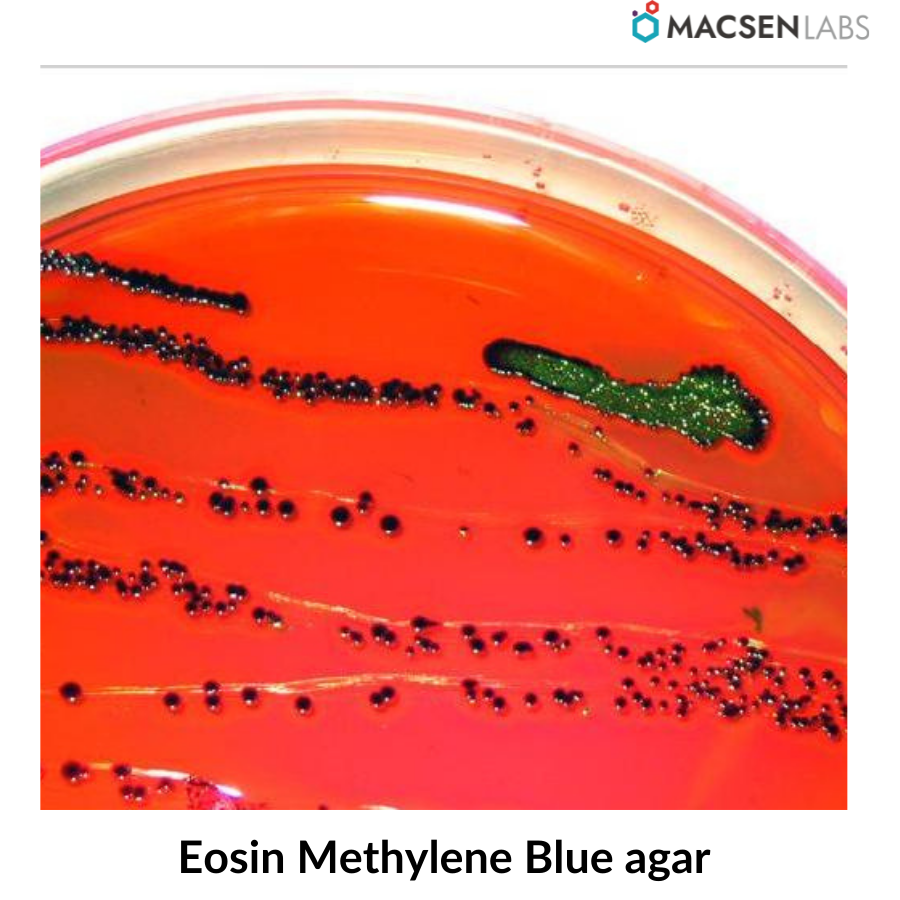Table of Contents
What is Eosin
Eosin is a fluorescent, xanthene dye or red dye formed with the action of bromine and fluorescein which binds to salts with eosinophilic compounds containing positive charges. In order to understand the general histological architecture of tissues, eosin is the most suitable stain combined with an alum hematoxylin. This stained solution can examine cytoplasm, collagen, and muscle fibers under a microscope.

Etymology
Heinrich Caro, the man who invented Eosin, decided to name the compound after the nickname (Eos) of a childhood friend called Anna Peters. It is derived from Eos, which means dawn in Greek and is also the name of the goddess of dawn in Greek.
Properties of Eosin

| Property | Description |
|---|---|
| Product name | Eosin |
| IUPAC name | disodium;2-(2,4,5,7-tetrabromo-3-oxido-6-oxoxanthen-9-yl)benzoate |
| Synonyms | Eosine Yellowish; Eosine; C.I. Acid Red 87; Bromoeosine; Sodium eosine; Bromo acid; Eosine Y; Eosina; Éosine; Bromofluoresceic acid; Certiqual Eosine; Aizen eosine GH |
| Chemical Formula | C20H6Br4Na2O5 |
| CAS No. | 17372-87-1; 548-26-5 |
| Molecular Weight | 691.9 g/mol |
| Appearance | Red crystalline powder, Hygroscopic |
| Melting point | 572 °F (decomposes) |
| Pubchem CID | 11048 |
Available Variants
When it comes to the variants of Eosin then it has two very closely related compounds used in histology. The available and the most used variants are:
- Eosin Y: It is also called Eosin Yellowish with a very slightly yellowish cast, Acid Red 87, C.I. 45380, bromoeosine, bromofluoresceic acid, etc. It is a derivative of fluorescein in tetrabromo form.
- Eosin B: It is also called Eosin Bluish with a very slightly bluish cast, Acid Red 91, C.I. 45400, Saffrosine, Eosin Scarlet, or imperial red. It is a derivative of fluorescein in dibromo dinitro form.
Each dye can be used interchangeably, and the choice is driven by preference and tradition.
How does Eosin stain work?
In addition to their use for over a century, eosin stains are still necessary for identifying various tissue types and changes in morphology. In addition, it is compatible with a wide variety of fixatives and possesses many features of the cytoplasm, nuclear, and extracellular matrix. Counterstaining is done with Eosin for the red color. It is up to the individual how intense the Eosin should be. “Eosin Y” is often widely used as eosin and identified with this name universally.
Uses
Use in histology
Eosin is used in combination with other dyes such as haematoxylin and methylene blue as a stain for different histological purposes. Depending upon the dye employed, we can classify them into following two staining techniques:
Hematoxylin and Eosin (H&E) staining
Hematoxylin and eosin (H&E) staining usually utilize eosin as a counterstain. In histology, H&E stains are one of the most common methods. Haematoxylin and eosin-stained tissues display cytoplasm that is pink-orange and nuclei that are dark purple or blue. In addition, eosin also detects intense red blood cells. Eosin Y is used in concentrations of 0.5–1% in histological examinations to stain cytoplasm, red blood cells, collagen, and muscle fibers.
H&E staining is the primary stain in histology Because it can be completed quickly, is inexpensive, stains tissues in a way that reveals a significant amount of microscopic anatomy, and can be used to identify a variety of histopathologic disorders.

Eosin-Methylene blue agar
Eosin methylene blue, or EMB, is a stain that is selective for Gram-negative bacteria as it consists of dyes that are harmful to Gram-positive bacteria and yeasts. It is also known as “Levine’s formulation.” It is a combination of eosin and methylene blue, with the proportions being 6:1 respectively along with other components such as peptone, lactose (optional), dipotassium phosphate, and agar.
EMB is a differential microbiological medium that gives a color signal to distinguish between organisms that ferment lactose (like E. coli) and those that do not while just minimally inhibiting the development of Gram-positive bacteria (e.g., Salmonella, Shigella). Lactose-fermenting organisms produce “nucleated colonies,” or colonies with dark centers.

Other uses
Eosin because of the presence of intense red blood cells, turns out to be red in color and this is why it is also used as red dye in inks but the molecules like Eosin Y, tend to degrade over time making the color darker over the time, this happens with the separation of bromine atoms from Eosin Y.
FAQs
Q. Is Eosin acidic or basic?
Eosin is an acidic dye i.e. negatively charged and most commonly used dye to stain the cytoplasm in histology that binds to the basic components of cells located in the cytoplasm.
Q. Is Eosin a natural dye?
Eosin is not a natural dye. It is a synthetic dye made from chemicals acting as a counterstain to hematoxylin blue color.
Q. What is eosin made of?
It is a red, crystallized dye made of potassium, sodium, or lead salts of tetrabromofluorescein, mainly used as an acid dye on Silk, Wool, Paper, Leather, and Cotton to produce a blood-red color.
Q. What is the effect of eosin on the skin cells?
Researchers have traditionally used eosin as a topical treatment for psoriasis to analyze how eosin affects the skin in vivo and the keratinocytes and endothelial cells in vitro. A course of eosin treatment reduces psoriatic infiltrates and dampens the release of proinflammatory chemokines and angiogenic factors.
Q. Where all can eosin methylene blue agar be used?
Gram-negative bacteria can be selectively cultured in eosin-methylene blue agar rather than gram-positive bacteria. In addition, EMB agar is useful for isolating and identifying various gram-negative bacteria, such as coliforms and fecal coliforms. t is a blend of two stains eosin and methylene blue.
Q. How eosin differs from hematoxylin and how to spot the difference?
Hematoxylin’s deep blue-purple color is caused by a complex, poorly understood reaction that stains nucleic acids. A similar reaction that stains proteins, eosin, is pink with the extracellular matrix.
Q. Which type of indicator is eosin?
Eosin has two variants eosin Y and eosin B and it is an artificial product of fluorescein and a class of fluorescent red dye.
Q. Can eosin be used for negative staining?
Eosin is used for negative staining. It is an acidic dye that stains the basic structures red or pink and is anionic.
Resources
Biological Stains | Classification, Examples & Uses
Disclaimer-
The information provided here is based on general knowledge, articles, research publications etc. and we do not claim the authenticity of any of the information provided above. We do not claim or suggest/advise any medical, therapeutic, health or nutritional benefits of Eosin. We do not supply or promote our Eosin product for the applications which are covered by valid patents and which are not approved by the FDA.
Macsen Labs is a manufacturer and supplier of several grades of Eosin such as:-

